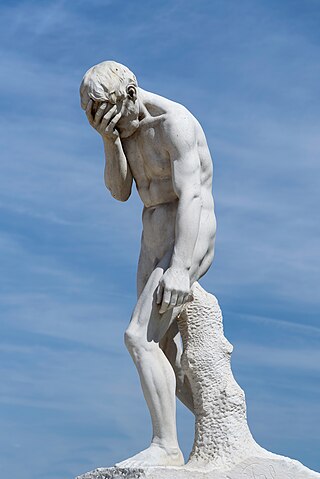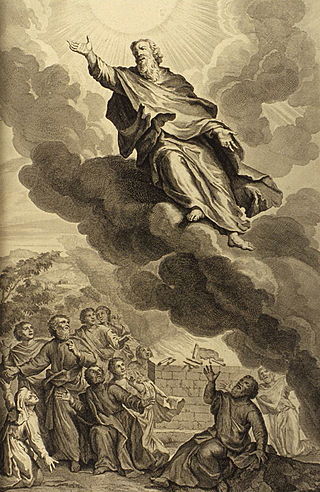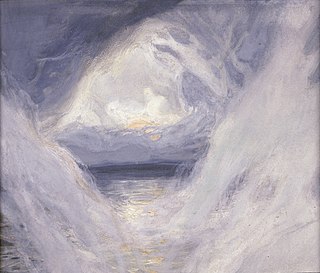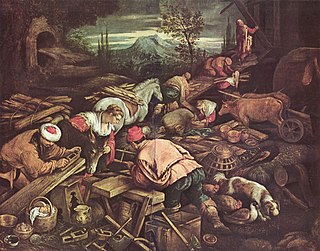
Methuselah was a biblical patriarch and a figure in Judaism, Christianity, and Islam. He had the longest lifespan of all those given in the Bible, having died at the age of 969. According to the Book of Genesis, Methuselah was the son of Enoch, the father of Lamech, and the grandfather of Noah. Elsewhere in the Bible, Methuselah is mentioned in genealogies in 1 Chronicles, Genesis, and the Gospel of Luke.

Cain is a Biblical figure in the Book of Genesis within Abrahamic religions. He is the elder brother of Abel, and the firstborn son of Adam and Eve, the first couple within the Bible. He was a farmer who gave an offering of his crops to God. However, God was not pleased and favored Abel's offering over Cain's. Out of jealousy, Cain killed his brother, for which he was punished by God with the curse and mark of Cain. He had several children, starting with Enoch and including Lamech.

Enoch is a biblical figure and patriarch prior to Noah's flood, and the son of Jared and father of Methuselah. He was of the Antediluvian period in the Hebrew Bible.

The antediluvian period is the time period chronicled in the Bible between the fall of man and the Genesis flood narrative in biblical cosmology. The term was coined by Thomas Browne. The narrative takes up chapters 1–6 of the Book of Genesis. The term found its way into early geology and science until the late Victorian era. Colloquially, the term is used to refer to any ancient and murky period.

Mahalalel is an Antediluvian patriarch named in the Hebrew Bible. He is mentioned in the Sethite genealogy as the grandfather of Enoch and subsequently the ancestor of Noah.
The Conflict of Adam and Eve with Satan is a 6th-century Christian extracanonical work found in Ge'ez, translated from an Arabic original.
The Trojan genealogy of Nennius was written in the Historia Brittonum of Nennius and was created to merge Greek mythology with Christian themes. As a description of the genealogical line of Aeneas of Troy, Brutus of Britain, and Romulus and Remus, the founders of Rome, it is an example of the foundation genealogies found not only in early Irish, Welsh and Saxon texts but also in Roman sources.

The patriarchs of the Bible, when narrowly defined, are Abraham, his son Isaac, and Isaac's son Jacob, also named Israel, the ancestor of the Israelites. These three figures are referred to collectively as "the patriarchs", and the period in which they lived is known as the patriarchal age.
The genealogies of Genesis provide the framework around which the Book of Genesis is structured. Beginning with Adam, genealogical material in Genesis 4, 5, 10, 11, 22, 25, 29–30, 35–36, and 46 moves the narrative forward from the creation to the beginnings of the Israelites' existence as a people.

Tubal-cain or Tubalcain is a person mentioned in the Bible, in Genesis 4:22, known for being the first blacksmith. He is stated as the "forger of all instruments of bronze and iron". A descendant of Cain, he was the son of Lamech and Zillah. Tubal-cain was the brother of Naamah and half-brother of Jabal and Jubal.

Lamech is a figure appearing in the Old Testament's Book of Genesis, where he is the seventh generation from Adam and father of the Jabal, the first breeder of livestock, Tubal-Cain, the first metalworker, Jubal, first musicians and Naamah; the list is comparable to the ancient Mesopotamian tradition of seven pre-flood heroes who originate arts and culture. This Lamech appears in the Yahwist genealogy ; the Priestly source has another Lamech who is the father of Noah.

The wives aboard Noah's Ark were part of the family that survived the Deluge in the biblical Genesis flood narrative from the Bible. These wives are the wife of Noah, and the wives of each of his three sons. Although the Bible only notes the existence of these women, there are extra-biblical mentions regarding them and their names.

Jared or Jered, in the Book of Genesis, was a sixth-generation descendant of Adam and Eve. His primary history is recounted in Genesis 5:18–20.
Encyclopaedia Biblica: A Critical Dictionary of the Literary, Political and Religion History, the Archeology, Geography and Natural History of the Bible (1899), edited by Thomas Kelly Cheyne and J. Sutherland Black, is a critical encyclopedia of the Bible. In theology and biblical studies, it is often referenced as Enc. Bib., or as Cheyne and Black.

The Genesis Apocryphon (1Q20), also called the Tales of the Patriarchs or the Apocalypse of Lamech and labeled 1QapGen, is one of the original seven Dead Sea Scrolls discovered in 1946 by Bedouin shepherds in Cave 1 near Qumran, a small settlement in the northwest corner of the Dead Sea. Composed in Aramaic, it consists of four sheets of leather. Furthermore, it is the least well-preserved document of the original seven. The document records a pseudepigraphal conversation between the biblical figure Lamech, son of Methuselah, and his son, Noah, as well as first and third person narratives associated with Abraham. It is one of the nonbiblical texts found at Qumran. A range of compositional dates for the work have been suggested from the 3rd century BC to 1st century AD. Palaeography and Carbon-14 dating were used to identify the age of the documents. It is 13 inches in length and 2.75 inches in width at its widest point in the middle.

Naamah is an individual mentioned in the Hebrew Bible, in Genesis 4:22. A descendant of Cain, she was the only mentioned daughter of Lamech and Zillah and their youngest mentioned child; her brother was Tubal-cain, while Jabal and Jubal were her half-brothers, sons of Lamech's other wife Adah. She is often conflated with or connected to Naamah of the Zohar, one of the first women to seduce the grigori and birth nephilim.

Lamech was a patriarch in the genealogies of Adam in the Book of Genesis. He is part of the genealogy of Jesus in Luke 3:36.

Selah, Salah or Sala or Shelah is an ancestor of the Israelites and Ishmaelites according to the Table of Nations in Genesis 10. He is thus one of the table's "seventy names". He is also mentioned in Genesis 11:12–15, 1 Chronicles 1:18–24, and Luke 3:35–36.

1 Chronicles 1 is the first chapter of the Books of Chronicles in the Hebrew Bible or the First Book of Chronicles in the Old Testament of the Christian Bible. The book is compiled from older sources by an unknown person or group, designated by modern scholars as "the Chronicler", and had the final shape established in late fifth or fourth century BCE. The content of this chapter is the genealogy list from Adam to Israel (=Jacob) in the following structure: Adam to Noah ; Noah's descendants from his three sons Shem, Ham, and Japheth: the Japhethites, Hamites, Semites ; the sons of Abraham ; the sons of Isaac. This chapter belongs to the section focusing on the list of genealogies from Adam to the lists of the people returning from exile in Babylon.















